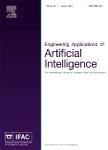版权所有:内蒙古大学图书馆 技术提供:维普资讯• 智图
内蒙古自治区呼和浩特市赛罕区大学西街235号 邮编: 010021

作者机构:Univ Texas Austin Austin TX 78712 USA Ben Gurion Univ Negev Beer Sheva Israel
出 版 物:《ENGINEERING APPLICATIONS OF ARTIFICIAL INTELLIGENCE》 (人工智能的工程应用)
年 卷 期:2021年第102卷
页 面:104265-104265页
核心收录:
学科分类:0808[工学-电气工程] 08[工学] 0811[工学-控制科学与工程] 0812[工学-计算机科学与技术(可授工学、理学学位)]
基 金:Israel Science Foundation [1055/14, 317/15] US Army Research Office [W911NF1810399] Helmsley Charitable Trust, USA through the Agricultural, Biological and Cognitive Robotics Initiative of BenGurion University of the Negev U.S. Department of Defense (DOD) [W911NF1810399] Funding Source: U.S. Department of Defense (DOD)
主 题:Multi agent coordination Wireless sensor networks Mobile agents Algorithm design
摘 要:In this paper, we study the problem of wireless sensor network (WSN) maintenance using a team of physical autonomous mobile agents. The agents are deployed in the area of the WSN in such a way that would minimize the time it takes them to reach a failed sensor and repair it. The team must constantly optimize its collective deployment to account for occupied agents. The objective is to define the optimal deployment and task allocation strategy, that minimize the solution cost. The solution cost is a linear combination of the weighted sensors downtime, the agents traveling distance, and penalties incurred due to unrepaired sensors within a certain time limit. Our proposed solution algorithms are inspired by research in the field of computational geometry and the design of our algorithms is based on state of the art approximation algorithms for the classical problem of facility location. We empirically compare and analyze the performance of several proposed algorithms. The sensitivity of the algorithms performance to the following parameters is analyzed: agents to sensors ratio, sensors sparsity, frequency and distribution of failures, repair duration, repair capacity, and communication limitations. Our results demonstrate that: (i) cooperation enhances the team s performance by orders of magnitude, (ii) k-Median based deployment algorithm provides up to 30% improvement in downtime, (iii) k-Center based deployment incurs 10% fewest penalties, and (iv) k-Centroid based deployment is most efficient in terms of minimizing the overall costs, with up to 21% lower cost than the next best algorithm.